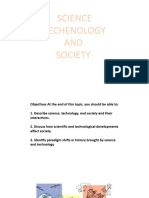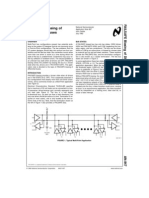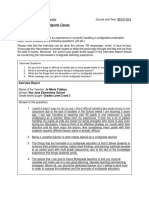0%(1)0% found this document useful (1 vote)
371 viewsFluctuating Stresses1
Fluctuating Stresses1
Uploaded by
Shubham Sharma1) Fatigue failure occurs when a material is subjected to repeated or fluctuating stresses below the material's yield point, causing progressive crack formation and unexpected failure without visible signs.
2) The fatigue properties of a material depend on factors like the maximum and minimum stress values, the number of load reversals, and the size and geometry of the component.
3) An S-N or Wöhler curve plots the stress amplitude versus the number of cycles to failure on logarithmic scales and is used to determine the endurance limit below which a material can withstand unlimited cycles without failing from fatigue.
Copyright:
© All Rights Reserved
Available Formats
Download as PPTX, PDF, TXT or read online from Scribd
Fluctuating Stresses1
Fluctuating Stresses1
Uploaded by
Shubham Sharma0%(1)0% found this document useful (1 vote)
371 views11 pages1) Fatigue failure occurs when a material is subjected to repeated or fluctuating stresses below the material's yield point, causing progressive crack formation and unexpected failure without visible signs.
2) The fatigue properties of a material depend on factors like the maximum and minimum stress values, the number of load reversals, and the size and geometry of the component.
3) An S-N or Wöhler curve plots the stress amplitude versus the number of cycles to failure on logarithmic scales and is used to determine the endurance limit below which a material can withstand unlimited cycles without failing from fatigue.
Original Description:
FLUCTUATING STRESSES PPT
Copyright
© © All Rights Reserved
Available Formats
PPTX, PDF, TXT or read online from Scribd
Share this document
Did you find this document useful?
Is this content inappropriate?
1) Fatigue failure occurs when a material is subjected to repeated or fluctuating stresses below the material's yield point, causing progressive crack formation and unexpected failure without visible signs.
2) The fatigue properties of a material depend on factors like the maximum and minimum stress values, the number of load reversals, and the size and geometry of the component.
3) An S-N or Wöhler curve plots the stress amplitude versus the number of cycles to failure on logarithmic scales and is used to determine the endurance limit below which a material can withstand unlimited cycles without failing from fatigue.
Copyright:
© All Rights Reserved
Available Formats
Download as PPTX, PDF, TXT or read online from Scribd
Download as pptx, pdf, or txt
0%(1)0% found this document useful (1 vote)
371 views11 pagesFluctuating Stresses1
Fluctuating Stresses1
Uploaded by
Shubham Sharma1) Fatigue failure occurs when a material is subjected to repeated or fluctuating stresses below the material's yield point, causing progressive crack formation and unexpected failure without visible signs.
2) The fatigue properties of a material depend on factors like the maximum and minimum stress values, the number of load reversals, and the size and geometry of the component.
3) An S-N or Wöhler curve plots the stress amplitude versus the number of cycles to failure on logarithmic scales and is used to determine the endurance limit below which a material can withstand unlimited cycles without failing from fatigue.
Copyright:
© All Rights Reserved
Available Formats
Download as PPTX, PDF, TXT or read online from Scribd
Download as pptx, pdf, or txt
You are on page 1of 11
FLUCTUATING STRESSES
FATIGUE FAILURE
• When a material is subjected to repeated stresses, it fails at stresses below the yield
point stresses. Such type of failure of a material is known as fatigue. The failure may
occur even without any prior indications. The fatigue of material is affected by the size of
the component, relative magnitude of static and fluctuating loads and the numbers of
load reversals.
Fatigue
Failure
Fluctuating Alternating Cyclic
Stress Stress Stress
FLUCTUATING STRESS
• The stresses which vary from a minimum
value to a maximum value of the same
nature (i.e. tensile or compressive) are
called fluctuating stresses.
CYCLIC STRESS
• The stresses which vary from one
value of compressive to the same
value of tensile or vice versa, are
known as completely reversed or
cyclic stress.
ALTERNATING STRESS
• The stresses which vary from a
minimum value to a maximum value
of the opposite nature(i.e. from a
certain minimum compressive to a
certain maximum tensile or from a
minimum tensile to a maximum
compressive) are called alternating
stresses.
S-N CURVE
• A SN-Curve (sometimes written
S-N Curve) is a plot of the
magnitude of a fluctuating stress
versus the number of cycles to
failure for a given material.
Typically both the stress and
number of cycles are displayed
on logarithmic scales.
ENDURANCE LIMIT
• If the stress is kept below a certain
value as shown by dotted line the
material will not fail whatever may be
the no. of cycles. This stress, as
represented by dotted line, is known
as ENDURANCE OR FATIGUE
LIMIT.
ENDURANCE LIMIT AND FATIGUE FAILURE
• It has been found experimentally that when a material is subjected to
repeated stresses, It fails at Is places below the yield point is stresses.
Such type of failure of a material is known as fatigue.
• The failure is caused by means of a progressive crack formation which
are usually fine and of microscopic size. The failure may occur even
without any prior indication.
• The fatigue of material is affected by the size of the component, relative
magnitude of static and fluctuating loads and the number of load
reversals.
STRESS CONCENTRATION
• Whenever a machine component changes the shape of its cross-section , the simple
stress distribution no longer holds good. This irregularity in the stress distribution
caused by abrupt changes of form is called stress concentration.
• A stress concentration (stress raisers or stress risers) is a location in an object where
stress is concentrated. An object is strongest when force is evenly distributed over its
area, so a reduction in area, e.g., caused by a crack, results in a localized increase in
stress.
• A material can fail, via a propagating crack, when a concentrated stress exceeds the
material's theoretical cohesive strength. The real fracture strength of a material is
always lower than the theoretical value because most materials contain small cracks
or contaminants that concentrate stress.
• It occurs for all kinds of stresses in the presence of fillets, notches, holes, keyways,
splines, surface roughness or scratches etc.
STRESS CONCENTRATION FACTOR
• When a machine member is subjected to cyclic or fatigue loading, the value of
fatigue stress concentration factor shall be applied instead of theoretical stress
concentration factor.
• Mathematically, fatigue stress concentration factor,
𝐸𝑁𝐷𝑈𝑅𝐴𝑁𝐶𝐸 𝐿𝐼𝑀𝐼𝑇 𝑊𝐼𝑇𝐻𝑂𝑈𝑇 𝑆𝑇𝑅𝐸𝑆𝑆 𝐶𝑂𝑁𝐶𝐸𝑁𝑇𝑅𝐴𝑇𝐼𝑂𝑁
𝐾𝑓 =
𝐸𝑁𝐷𝑈𝑅𝐴𝑁𝐶𝐸 𝐿𝐼𝑀𝐼𝑇 𝑊𝐼𝑇𝐻 𝑆𝑇𝑅𝐸𝑆𝑆 𝐶𝑂𝑁𝐶𝐸𝑁𝑇𝑅𝐴𝑇𝐼𝑂𝑁
You might also like
- (L. S. Srinath) Advanced Mechanics of Solids 3Document521 pages(L. S. Srinath) Advanced Mechanics of Solids 3Chitrang Bohra92% (26)
- Extra WEAR SolutionsDocument7 pagesExtra WEAR SolutionsGiannis MamalakisNo ratings yet
- Quiz Game C++ Project Class 12thDocument31 pagesQuiz Game C++ Project Class 12thAshwin PunalekarNo ratings yet
- Garden DSR Civil 2016-17 FinalDocument218 pagesGarden DSR Civil 2016-17 FinalShruti DamgirNo ratings yet
- Variable Stress AnalysisDocument43 pagesVariable Stress AnalysisCayle MalitNo ratings yet
- Designing Lightweight Diesel Engine Alternator Support Bracket With Topology Optimization MethodologyDocument21 pagesDesigning Lightweight Diesel Engine Alternator Support Bracket With Topology Optimization MethodologyAhmad AmeerNo ratings yet
- MOS-I (Lecture-2)Document17 pagesMOS-I (Lecture-2)Khalid YousafNo ratings yet
- Impact IzodDocument6 pagesImpact IzodTanu RdNo ratings yet
- Tensile Testing of Ferrous and Non-Ferrous AlloyDocument7 pagesTensile Testing of Ferrous and Non-Ferrous Alloyrama100% (1)
- PPT4. PlasticityIITKDocument70 pagesPPT4. PlasticityIITKKartik Shankar KumbhareNo ratings yet
- Torsion Civil EngineeringDocument43 pagesTorsion Civil Engineeringhaseebtkhan100% (1)
- Tut Failure TheoriesDocument39 pagesTut Failure TheoriesKamil Hakan TuranNo ratings yet
- ME - 32021 Chapter (I) Machining Processes and Machine Tools - PPTX (Repaired)Document23 pagesME - 32021 Chapter (I) Machining Processes and Machine Tools - PPTX (Repaired)WILYNo ratings yet
- Strength of Metirials QUSDocument5 pagesStrength of Metirials QUSraviNo ratings yet
- Subject: Arch315-Strength of MaterialsDocument15 pagesSubject: Arch315-Strength of MaterialsAlyssa MadelNo ratings yet
- ANALYSIS OF STRAINS Assignment 2 PDFDocument3 pagesANALYSIS OF STRAINS Assignment 2 PDFLuWang Alex100% (1)
- Strength of Materials 2015 by S K MondalDocument471 pagesStrength of Materials 2015 by S K MondalNaman Jain100% (1)
- Chapter 4 Torsion PDFDocument30 pagesChapter 4 Torsion PDFadlinasir67% (3)
- Stresses in Machine ElementsDocument18 pagesStresses in Machine ElementsthirumalaikumaranNo ratings yet
- 2 Design Against Fluctuating LoadsDocument68 pages2 Design Against Fluctuating Loadssri kiranNo ratings yet
- Design of Machine Elements 2 6Document25 pagesDesign of Machine Elements 2 6sasikskNo ratings yet
- Mechanics of Materials - Column Buckling TestDocument13 pagesMechanics of Materials - Column Buckling TestDavid Clark93% (14)
- Me8593 Design of Machine Elements: M.A.M. College of Engineering and TechnologyDocument66 pagesMe8593 Design of Machine Elements: M.A.M. College of Engineering and TechnologymanikandanNo ratings yet
- DME-Online Class Sep2020-Module 2-PartB PDFDocument37 pagesDME-Online Class Sep2020-Module 2-PartB PDFMathew John100% (1)
- Engineering Mechanics Lab ManualDocument44 pagesEngineering Mechanics Lab ManualengrburhanNo ratings yet
- SOM 2 MarksDocument8 pagesSOM 2 MarksSiva ShanmugamNo ratings yet
- Strength of Materials 2 Mark QuestionsDocument21 pagesStrength of Materials 2 Mark Questionsrameshbabu_1979No ratings yet
- Principal Stresses and StrainsDocument44 pagesPrincipal Stresses and Strainskavi krishna100% (2)
- Thin Walled Pressure Vessels: 1 Er. Shova ShresthaDocument43 pagesThin Walled Pressure Vessels: 1 Er. Shova Shresthacoded coderNo ratings yet
- Theories of FailureDocument9 pagesTheories of FailureNarlanka UdhbhavNo ratings yet
- Chapter 5 Principal Stresses PDFDocument61 pagesChapter 5 Principal Stresses PDFcoded coderNo ratings yet
- Elementary Statics and DynamicsDocument15 pagesElementary Statics and DynamicsPooja Bk0% (1)
- CH 02Document9 pagesCH 02Ahmed M TNo ratings yet
- Frequency of Free Damped Vibrations (Viscous Damping)Document8 pagesFrequency of Free Damped Vibrations (Viscous Damping)ذوالفقار علي حسينNo ratings yet
- Assignment 2 CVG 2140Document8 pagesAssignment 2 CVG 2140KrisNo ratings yet
- Chapter 1 - 1D and 2D Linear Stress Strain (Basic Solid Mechanics)Document121 pagesChapter 1 - 1D and 2D Linear Stress Strain (Basic Solid Mechanics)dixn__No ratings yet
- Two-Degree-of-Freedom SystemsDocument19 pagesTwo-Degree-of-Freedom SystemsMarwan NasserNo ratings yet
- Reinforced Concrete Structures I II-2016 - Chapter 2Document29 pagesReinforced Concrete Structures I II-2016 - Chapter 2Semahegn GebiruNo ratings yet
- 06 Sept - Inversions of Slider CrankDocument34 pages06 Sept - Inversions of Slider CrankSreejith SreeNo ratings yet
- 2 Stability Assessment of Temporary Rock Cut SlopeDocument61 pages2 Stability Assessment of Temporary Rock Cut SlopeJoseph LuuNo ratings yet
- Ductile Failure Behavior of Polycrystalline Al 6061-T6Document26 pagesDuctile Failure Behavior of Polycrystalline Al 6061-T6Mohamed RamadanNo ratings yet
- MCQs With SolutionDocument4 pagesMCQs With SolutionPinalNo ratings yet
- Torsion TestDocument7 pagesTorsion Testilya danisyahNo ratings yet
- Fluid Mechanics Sessional CE 262Document28 pagesFluid Mechanics Sessional CE 262মোঃমেহেদী হাসান শরীফNo ratings yet
- Columns and Struts - Strength of Materials - Part 1 PDFDocument9 pagesColumns and Struts - Strength of Materials - Part 1 PDFgvkpower33% (3)
- Strength of Materials PDFDocument48 pagesStrength of Materials PDFJohnNo ratings yet
- Maximum Distortion Energy Theory or Von Mises CriteriaDocument2 pagesMaximum Distortion Energy Theory or Von Mises CriteriaMonojit KonarNo ratings yet
- EMM213 Strength of Materials: TorsionDocument25 pagesEMM213 Strength of Materials: TorsionNorwahida YusoffNo ratings yet
- CH 6 Fatigue Failure Resulting From Variable Loading 2015Document113 pagesCH 6 Fatigue Failure Resulting From Variable Loading 2015Zaher ZaherNo ratings yet
- Finite Element Method in Structure Assignment-4Document16 pagesFinite Element Method in Structure Assignment-4Natinael WoldeNo ratings yet
- Theories of Failure: Prof. H. Sudarsana RaoDocument29 pagesTheories of Failure: Prof. H. Sudarsana RaoJoel Peters100% (1)
- 4.failure Theories and Stress ConcentrationsDocument21 pages4.failure Theories and Stress ConcentrationsAmr El SaeedNo ratings yet
- ElasticityDocument8 pagesElasticityGuru GuroNo ratings yet
- Chapter 9 - Stress - Transformation (Equations)Document41 pagesChapter 9 - Stress - Transformation (Equations)Nyan Htet WinNo ratings yet
- Simple Stresses and Strains PDFDocument104 pagesSimple Stresses and Strains PDFyaminiNo ratings yet
- FEA Optimization GuideDocument4 pagesFEA Optimization Guidea3576159No ratings yet
- CE2155 - Combined LoadingsDocument21 pagesCE2155 - Combined LoadingsJuliaNo ratings yet
- Strength of Masterials - IDocument72 pagesStrength of Masterials - IpradeepNo ratings yet
- Som BasicsDocument26 pagesSom BasicsTarun AgarwalNo ratings yet
- Strength of MTRL Chap1&2Document25 pagesStrength of MTRL Chap1&2Abraham DerejeNo ratings yet
- Lecture 3 - ElasticityDocument13 pagesLecture 3 - ElasticityAbdul Azim Bin Abu Bakar E22A0281No ratings yet
- Mechanical Properties Based On Elastic Deformation: Stress-Strain DiagramDocument16 pagesMechanical Properties Based On Elastic Deformation: Stress-Strain DiagramNoob SssNo ratings yet
- Spectral method for fatigue damage estimation with non-zero mean stressFrom EverandSpectral method for fatigue damage estimation with non-zero mean stressNo ratings yet
- Tool Nose Radius Compensation in CNC TurningDocument5 pagesTool Nose Radius Compensation in CNC TurningShubham SharmaNo ratings yet
- Lec 4Document16 pagesLec 4Shubham SharmaNo ratings yet
- Eem507 Electrical Technology: Unit - 1 D.C.MotorDocument7 pagesEem507 Electrical Technology: Unit - 1 D.C.MotorShubham SharmaNo ratings yet
- Maths AaDocument23 pagesMaths AaShubham SharmaNo ratings yet
- Mem503: Mechanics of Solids - Ii Syllabus: Analysis of Stress and StrainDocument11 pagesMem503: Mechanics of Solids - Ii Syllabus: Analysis of Stress and StrainShubham SharmaNo ratings yet
- Everything About BIO-ROBOTICSDocument21 pagesEverything About BIO-ROBOTICSShubham Sharma100% (2)
- Processes and Impacts of Strategic Management ArticleDocument4 pagesProcesses and Impacts of Strategic Management ArticleAlhaji DaramyNo ratings yet
- Partner Ordering Brown Bag External SessionDocument30 pagesPartner Ordering Brown Bag External SessionHope HimuyandiNo ratings yet
- Erlandson Et Al. 2008Document14 pagesErlandson Et Al. 2008Olenka AlexandraNo ratings yet
- MET ONE 6000P Series Remote Airborne Particle Counters: High Performing, Reliable 0.5 M Sensitivity RemoteDocument4 pagesMET ONE 6000P Series Remote Airborne Particle Counters: High Performing, Reliable 0.5 M Sensitivity Remotert2iNo ratings yet
- RISC-V Lab Project PDFDocument21 pagesRISC-V Lab Project PDFAli ShafiqueNo ratings yet
- Architektur Galerie BerlinDocument3 pagesArchitektur Galerie BerlinAram AdivNo ratings yet
- Science q1 w3 Factors Affecting SolubilityDocument20 pagesScience q1 w3 Factors Affecting SolubilityMallen MallenNo ratings yet
- Science Techenology AND SocietyDocument37 pagesScience Techenology AND SocietyRyan Christian M. PeriaNo ratings yet
- University of Northern PhilippinesDocument2 pagesUniversity of Northern PhilippinesCezanne Cruz0% (1)
- EPAM - CU 24 May 2024, Assessment Result.Document4 pagesEPAM - CU 24 May 2024, Assessment Result.Shashank shekharNo ratings yet
- TO5 Ecfe OutputDocument11 pagesTO5 Ecfe OutputSurojit PaulNo ratings yet
- Report 2 Rolling Stock - MOUD INDIADocument160 pagesReport 2 Rolling Stock - MOUD INDIADeepak GadkariNo ratings yet
- Limit and Limit and Continuity Preparation Tips For IIT JEE - askIITiansContinuityDocument8 pagesLimit and Limit and Continuity Preparation Tips For IIT JEE - askIITiansContinuityaskiitianNo ratings yet
- An 847 RS 485Document6 pagesAn 847 RS 485Tomislav StudakNo ratings yet
- BT5RDocument10 pagesBT5RNikka Noelle MiguelNo ratings yet
- Guide To Preparation of Stock Standard SolutionsDocument61 pagesGuide To Preparation of Stock Standard SolutionsarleneNo ratings yet
- Servo-Pneumatic Drive Solution For Welding Guns: Sturdy and Precise!Document6 pagesServo-Pneumatic Drive Solution For Welding Guns: Sturdy and Precise!Irappa HosamaniNo ratings yet
- Agile Landscape: LAST 2016Document29 pagesAgile Landscape: LAST 2016MbellattiNo ratings yet
- Structural Calculation of Box Culvert Type: B1.00m X H1.00m Class V Road Soil Cover Depth: 0.0 M 1 Dimensions and ParametersDocument29 pagesStructural Calculation of Box Culvert Type: B1.00m X H1.00m Class V Road Soil Cover Depth: 0.0 M 1 Dimensions and ParametersBambang ZidaneNo ratings yet
- 0 - Intro - Fanuc Robot Training 8 How To Pick Up Pallets and Multiple PalletsDocument7 pages0 - Intro - Fanuc Robot Training 8 How To Pick Up Pallets and Multiple PalletsMinh Nguyen HoangNo ratings yet
- Prymax Healthcare LLPDocument24 pagesPrymax Healthcare LLPrythmdipenNo ratings yet
- Music Preferences and The Adolescent Brain: A Review of LiteratureDocument7 pagesMusic Preferences and The Adolescent Brain: A Review of LiteratureRocíoNo ratings yet
- Manual de Servicio Pioneer KEH-P1010Document38 pagesManual de Servicio Pioneer KEH-P1010Vicente E. Marin L.No ratings yet
- Gujarat Technological UniversityDocument2 pagesGujarat Technological Universityvifaket581No ratings yet
- 2a - Professional Task English - Module B Standard Close Study of LiteratureDocument50 pages2a - Professional Task English - Module B Standard Close Study of Literatureapi-374401563No ratings yet
- TEGR 120-Teaching Multigrade Classes: Learning Task# 2Document1 pageTEGR 120-Teaching Multigrade Classes: Learning Task# 2MD BadillaNo ratings yet
- Product Data: Castrol Blue Hydraulic PlusDocument3 pagesProduct Data: Castrol Blue Hydraulic PlusGabriel Torres BenturaNo ratings yet
- Buiding Maintenance and ManagementDocument67 pagesBuiding Maintenance and ManagementBashir IdrisNo ratings yet
































































































